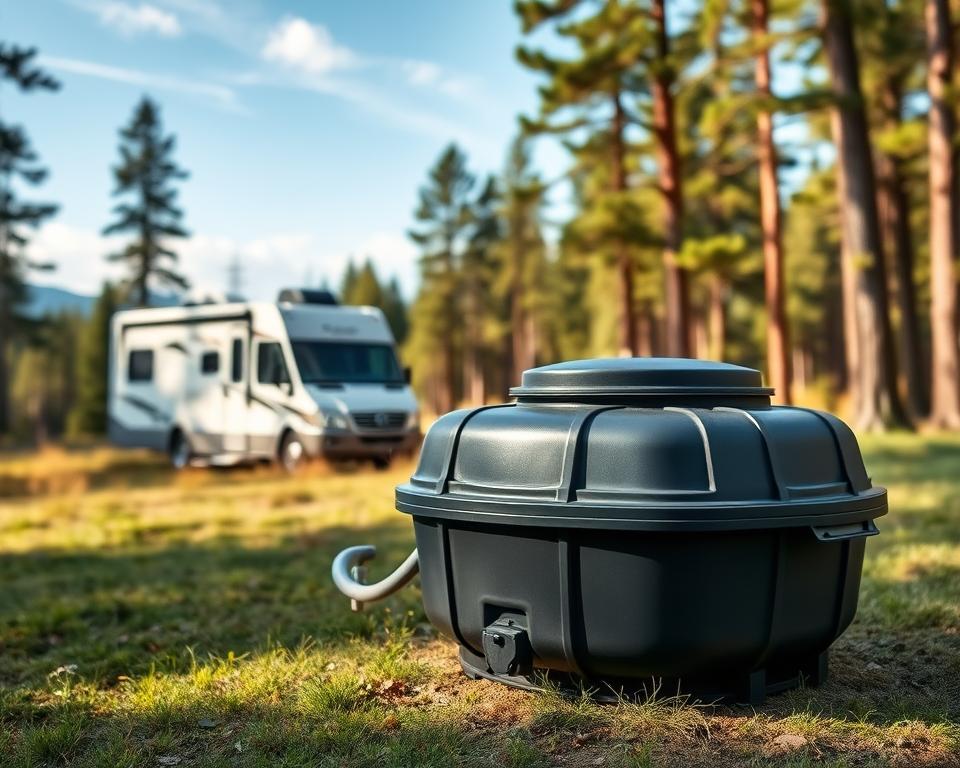RV Waste Tank Pumping: Vital Maintenance Advice
Imagine what happens when you ignore your RV’s sewer setup. A lot of motorhome owners dread tank emptying. Yet, recognizing the need for regular servicing is crucial. Such measures keep your trips worry-free and prevent costly fixes. Mastering correct waste handling is fundamental to your system’s longevity. We’ll share vital insights on RV sewage pump, including best practices and tips to keep your system running smoothly.
The Basics of Your RV Sewage System
Every recreational vehicle features a septic setup. The system comprises a black water tank (toilet), a gray water tank (sinks/showers), and a fresh water tank. Grasping how each part works is key to proper black tank servicing and overall system care.
A series of drain lines and vent pipes balance waste flow and airflow. A good grasp prevents clogs and nasty odors. It’s the foundation of a smooth camping experience.
Regular checks and care keep your tanks in top shape. Frequently checking tank levels and emptying on time preserves comfort. By maintaining your RV’s septic system properly, you’ll improve its lifespan and enjoy every trip more.
Importance of Regular RV Septic Tank Pumping
Frequent tank pumping keeps your system working and clean. Waste buildup triggers odors and backups that ruin outings. Overfilled tanks risk ugly overflows. These incidents mar your travel enjoyment.
Skipping pump-outs leads to pricey repairs. System failures cause leaks and wear out parts prematurely. Timely emptying keeps your plumbing running smoothly. It prevents unwelcome surprises and roadside emergencies.
Staying on top of maintenance wards off backups. Dedicating effort to pumping reflects good RV stewardship. Your trips become more relaxing. A strict pumping routine lets you enjoy camping without septic concerns.
Recommended Pump-Out Intervals
Timing your tank dumps depends on several variables. Common guidance suggests a 3–5-day window. However, it shifts based on tank volume and number of users. Knowing when to pump is vital for managing RV wastewater.
Empty once the black tank reaches roughly 66% full. This prevents solids from clogging and keeps flow steady. Skipping this leads to blockages and smells that spoil the trip.
Various factors influence dump frequency, such as
- Number of people on board
- Length of stay
- Type of waste generated
- Tank capacity
Scheduling prevents on-the-road crises. Sync with any public dump station hours. Tracking your usage helps forecast dump needs.
| Usage Scenario | Pumping Frequency |
|---|---|
| Weekend Getaway (2 people) | Every 3–4 days |
| Extended Trip (4–6 people) | Every 2–3 days |
| Seasonal Living (2–4 people) | Weekly or Bi-Weekly |
Monitor fill levels and usage patterns. This proactive stance ensures enjoyable travel.

Proper Tank Dumping Techniques
Correct dumping preserves system health and prevents issues. Begin with the black tank to avoid cross-contamination. This prevents dirty water from fouling the clean.
A sturdy sewer hose reduces spill chances and aids flow. Tighten connections to stop spills. After emptying, flush the black tank with plenty of water. It clears lingering waste for a cleaner tank.
Scout dump spots along your route. Being prepared saves time on the road.
To summarize, use these steps:
- Empty the black water tank first.
- Use a top-quality sewer hose.
- Flush the black tank thoroughly after emptying.
- Plan your dump station locations.
Following these guidelines simplifies black tank maintenance.
How to Care for Your Black and Gray Tanks
Grasping correct handling of black and gray tanks ensures system health. Keep some water in the black tank for better breakdown.
Don’t flush wipes, feminine products, or paper towels. Always use RV-safe toilet paper to prevent clogs. Inspect tanks often to catch problems early.
Adding treatments now and then improves septic service. They introduce microbes that digest solids effectively. Such measures keep your tanks operating at their best.
- Check for leaks and damage often.
- Apply RV-specific chemical treatments.
- Keep vents clear to avoid odors.
Following these rules protects your septic setup. You’ll enjoy more worry-free trips.
How to Pump Efficiently
Successful pumping requires precision and a clear procedure. It’s essential to use designated dump stations. Understanding volume limits prevents spills on the go.
Monitoring levels guides your dump schedule. This extends tank life and enhances trip comfort. Setting a dumping schedule improves system efficiency.
Flush well after every emptying. It ensures each dump is cleaner than the last. Such tactics keep your rig in top shape and improve your travel experiences.
Common Mistakes to Avoid When Maintaining Your RV Septic System
Upkeep prevents trip interruptions. Insufficient flushing causes solids to accumulate. Adequate water use breaks down solids efficiently.
Flushing inappropriate items blocks pipes. Avoid non-dissolvable products like feminine hygiene items. They cause backups and costly service calls.
Leaving the black valve open too early is a mistake. Premature opening prevents a full flush. This ensures solids clear on each dump.
Awareness of these errors boosts system longevity. Steering clear of these mistakes ensures durable performance.
When to Seek Professional Septic Services
Knowing when to hire pros preserves system health. Lingering smells can mean serious tank problems. Slow drains point to potential clogs or buildup.
Waste spillage near dump sites signals trouble. Such situations usually need high-pressure cleaning. Experts use specialized tools to clear stubborn clogs.
Routine professional inspections catch hidden issues early. Early intervention avoids expensive failures. Professional service ensures proper functionality.
Long-Term Maintenance for Your RV Wastewater Management
Long-term strategies sustain wastewater efficiency. Scheduled dumps preserve longevity and operation. Flushing often prevents buildup and costly repairs.
Adopting sanitation routines protects your system. Checking seals and joints avoids leaks. Opting for biodegradable products protects plumbing.
Keep these habits in mind:
- Stick to a pump-out timetable.
- Rinse often to remove solids.
- Sanitize twice a year.
- Inspect parts frequently for wear and tear.
Investing in prevention brings peace of mind. Routine service lets you focus on the scenery, not your sewer.
The Bottom Line
Effective RV septic maintenance is crucial for a pleasant experience. Knowing system function and cleaning steps stops issues. Routine black tank dumping boosts performance. It enhances every mile.
Consistent inspections and care deliver trouble-free trips. Dependable sewage service backs every adventure. Adopting these habits keeps your RV ready to roll. Thus, you can concentrate on adventures rather than septic concerns.

